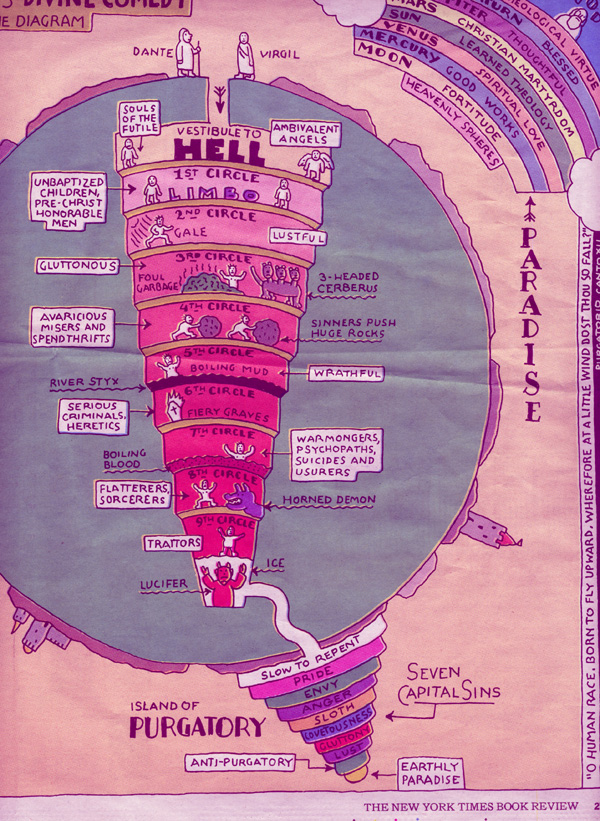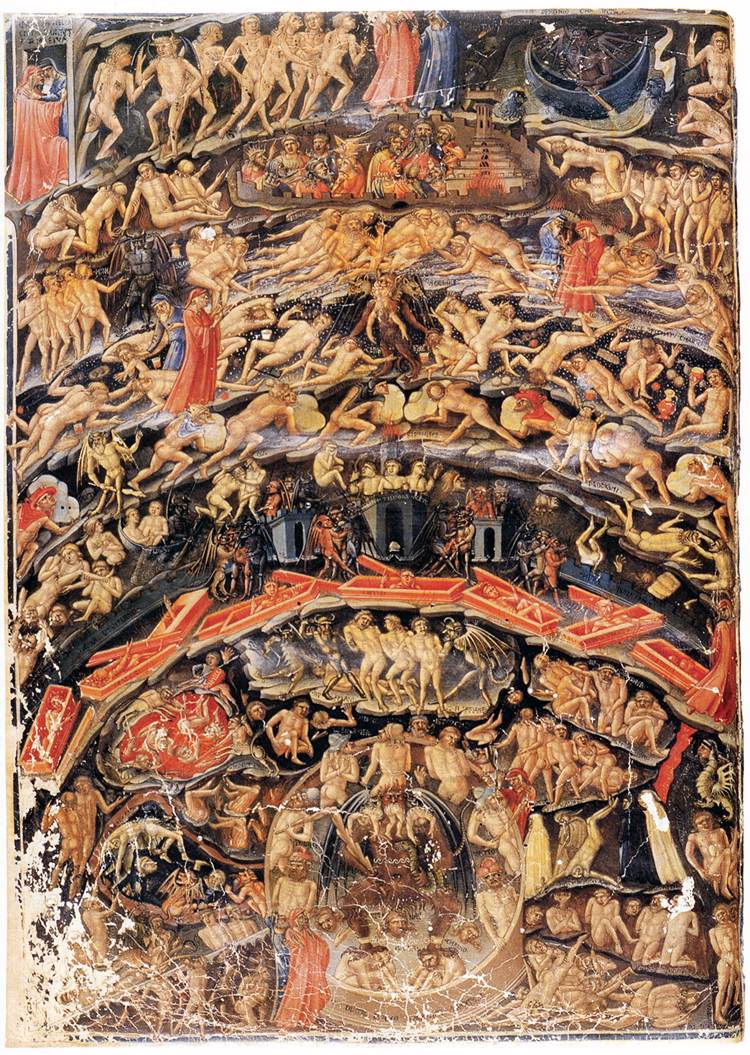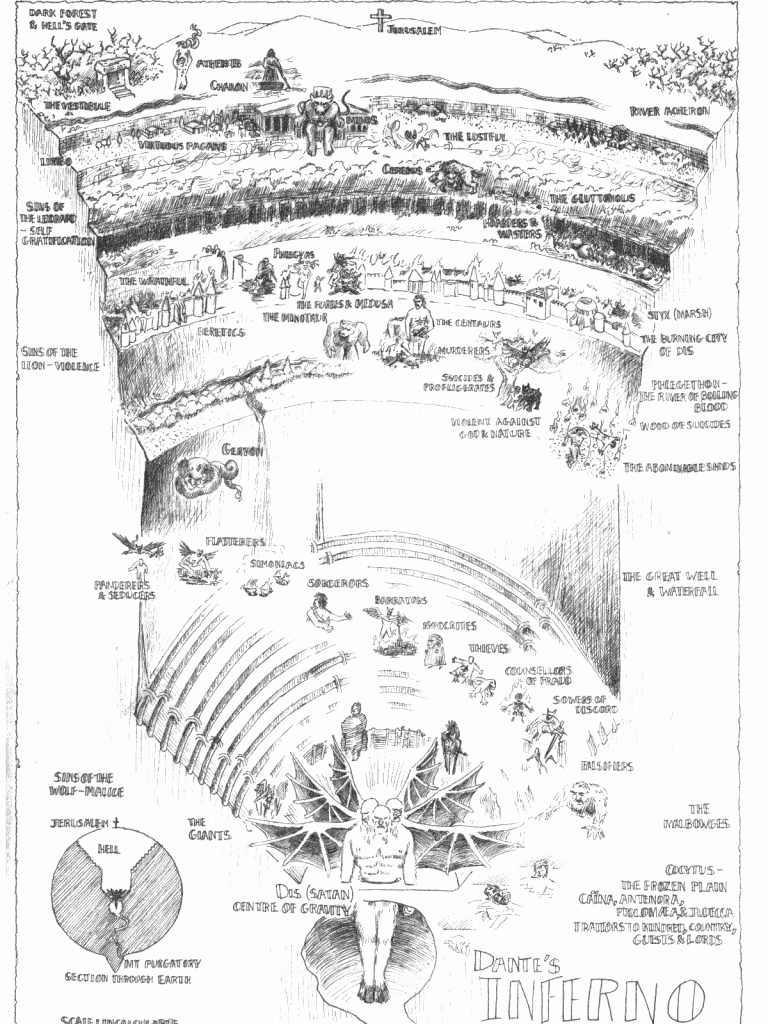I’m always surprised that there haven’t been vastly more attempts to capture, in a single image, the architectural entirety of Dante’s Hell, if not the other two regions. (You can see which one dominates in the above picture.) Hell is by far the most sensible (sensory, that is), visceral realm, as Anne Stevenson so well put it:
In the Museum of Floating Bodies and Flammable Souls
Painters who painted the flights of martyrs for money,
Who filled the drapery of angels with rose-tinted oil,
Had to please rich patrons with trapeze acts of the body,
Since no one can paint the electricity of the soul.My lady in her blue silk cowl must by now be topsoil;
She swans into Heaven, almond eyes uplifted in piety.
My lord kneels at prayer in a cassock, blade at his heel.
Not a single electron remains of his sin or sanctity.While in Hell, for example in the water church of Torcello,
The wicked receive their desserts. Disembowelled and dismembered,
They are set upon eternally, yet their bodies alone are touched;
Unless souls, flushed out of the flesh, are the flames that torch them.No wonder evil’s so interesting and goodness so pitifully dull.
Torture of the body symbolizes torture of the mind;
And burning in the bonfires of conscience is hardly confined
To hell for bad Italians, who, being damned, are being saved as well.
I suppose the thing is just too massive, encompassing an entire cosmos, as Erich Auerbach said in his book on Dante. Botticelli certainly did brilliantly on the massive front, but I have an affection for the more human-scale version by Bartolomeo, which replaces the vastness with claustrophobia:
The Driftless Area Review recently posted a set of Infernal images in The Landscape of Hell, including this lovely version of Dante’s:



17 February 2011 at 09:26
The Bartolomeo is wonderful, but the illustration from the NYT has considerable charm too.
17 February 2011 at 15:19
the key or legend in the lower left of the last panel nicely captures the “single bullet theory” of what happened when Satan got shot out of heaven (Satan himself being the bullet). All the material from the impact crater caused by his fall pushed out the mountain of purgatory; in effect, then, hell, purgatory and Eden were all created simultaneously. Now the physics here looks pretty suspect, but then lots of people also say that about the Warren Commission conclusions.
17 February 2011 at 16:56
Ockham’s razor makes the single-bullet theory terribly appealing, but isn’t that a case of the Manicheistic heresy? (See James Blish’s A Case of Conscience for further details.) But what created the secret passageway? Did a hangnail fall off of Satan and drill it? And why didn’t they take the secret passageway in the first place and work backwards so that the movement of of the poem was unidirectional, from the Antipodes to God?
I see some have suggested that the sound they are following is the river Lethe! Very interesting, that.
18 February 2011 at 04:12
I’m not a Dante scholar, but it was my understanding that the island of Purgatory is the antipodes of Jerusalem. Whether Jerusalem stands over the site of Satan’s crash is another question, I suppose. And at the risk of being even more pedantic, isn’t the movement of the poem already unidirectional? They pass down through the Earth, emerge on the other side, climb the mountain, and go into the sky, which is directly above the Earth’s surface, even at the antipodes. The drawing makes it look disjointed, but the drawing forgets that not only is the world round but also the heavens. So to speak.
18 February 2011 at 23:53
Fair point, fair point. Morally unidirectional might be the better term. Which is to say in the pursuit to give increasing intensity to each of the three sections, with the appearance of Satan, Beatrice, and God at the end of each (Beatrice a bit before the end), the parallels create the odd fact that Satan makes his appearance at the 1/3 mark. Odd to me, anyway.
20 February 2011 at 23:08
It is an odd decision–and an intentional one, I suspect. There are 2 things in play here.
First, I think he wanted to put Satan in the most minor position possible. The greatest sinner is less than the merest saved. This hierarchy extends even to figures toward whom he is positively disposed. Virgil, the poet Dante most admired, is forced through a series of humiliations in the text. His artistic magnificence does not preponderate over his heathen beliefs, and he must suffer eternity in the shade of God’s regard. (That Cato is saved is, of course, most bizarre.)
The second thing is Beatrice. Dante was willing–and I love this about The Divine Comedy–to insert his personal relationships into the vast canvas of his epic. This is the truly odd and awe-inspiring decision. The poem’s ambition is unlimited–some think he believed he was contributing another testament of the Bible–and also perversely minor. Part of that perversity was a conviction that Beatrice was in fact a major figure in Heaven, and the Divine Comedy was his way of making that truth known. Her position in the Purgatory book, at the point where Satan and God appear in the other books, tells us that if we aren’t excited to see her, we should be.
15 March 2011 at 16:54
This one by Domenico di Michelino in Florence does Purgatory right:
15 March 2011 at 16:55
Oops — I guess some html is not all right. (Undistributed term, some.) Here’s the url:
http://www.lib-art.com/imgpainting/2/0/9102-dante-illuminating-florence-with-hi-domenico-di-michelino.jpg